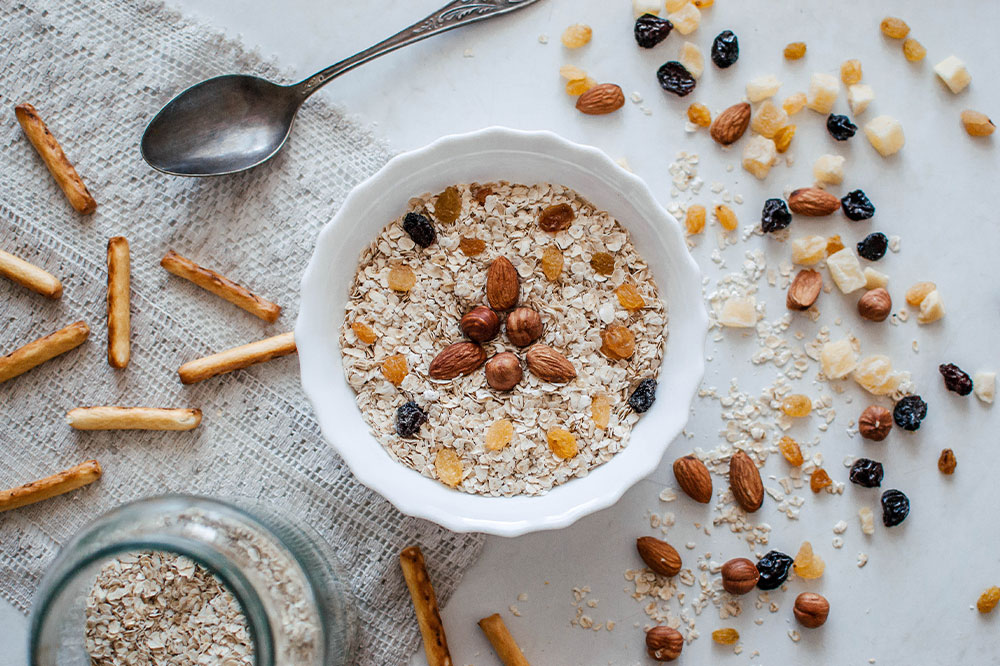7 snack ideas for lowering cholesterol levels

The CDC suggests that about 38% of adults in the country have high cholesterol levels. This puts them at risk of heart diseases and serious complications. So, it is important to regulate ones bad cholesterol levels by getting an adequate amount of heart-healthy fats and fiber. Adding sources like fruits, vegetables, seeds, nuts, whole grains, and legumes can help one get the necessary nutrients. So, here are seven snack ideas to lower one’s cholesterol levels:
Oatmeal
The versatility of oats is unmatched, so one can add them to any recipe of choice. Additionally, oatmeal is the go-to snack when it comes to lowering cholesterol. It is rich in soluble fibers that bind to cholesterol and flush them out before they can reach the bloodstream. Besides fiber, one serving of oatmeal contains high levels of protein and heart-friendly antioxidants. Fresh or dried fruits and honey are recommended additions to oatmeal as they can help achieve better results.
Fruit bowl
Fruit bowls are another way of adding low-cholesterol snacks into one’s daily diet. Fruits are incredibly rich in fiber and can make people feel full for extended periods. Additionally, they are a rich source of essential minerals and vitamins. Some of the most effective foods include almonds and fruits like berries and apples. However, managing portion size is crucial as certain fruits can be high in carbohydrates. Here is what one can use for a healthy and well-balanced fruit bowl:
8 strawberries
1 medium-sized apple
A handful of grapes
2 tablespoons of flaked almonds or other nuts
Yogurt parfait
Low-cholesterol snacks do not have to be bland or boring. In fact, yogurt parfaits are the perfect example of delicious snacks people can have. One can add loads of fruit to the recipe. Yogurt fruit parfaits are an upgraded version of fruit salads. This dessert comprises at least three ingredients—frozen or fresh fruits, sauces, and nuts, each stacked in layers in glasses instead of a bowl. Here, the bottom layer consists of yogurt that enhances the taste and texture of fruits. Parfaits are healthy snack options that contain loads of protein and vitamins A, C, D, and B-12. Additionally, this snack looks exceptionally appealing. The inclusion of yogurt makes the recipe high in significant nutrients like magnesium, iron, and calcium.
Nuts
Often one may not feel like whipping up an evening snack, so, instead, what they can do is keep jars of nuts and seeds in handy and have them as snacks. Also, these are perfect ingredients for delicious trail mixes. Nuts and seeds contain healthy fats and high protein content. When accompanied by dark chocolate and fruits, they become delicious nutrient-rich options with heart-healthy antioxidants.
Chocolate-dipped berries
This is a snack that does not negatively affect cholesterol levels and helps increase happy hormones. The benefits of dark chocolate are no longer unknown. It is a significant source of several nutrients, including iron, magnesium, copper, manganese, potassium, and zinc. Dark chocolate can help reduce blood pressure and heart disease risks if had in moderation. It primarily contains cocoa solids, which in turn are rich in flavonoids—an antioxidant found in several healthy vegetables and fruits. Dark chocolate can be an ideal snack when accompanied by berries and fruits, especially strawberries. This is because strawberries are a low-calorie fruit that contains no sodium, fat, or cholesterol. Additionally, they are a rich source of several essential nutrients like vitamins, fiber, and antioxidants called polyphenols.
Homemade popcorn
Popcorn can be a convenient low-cholesterol snack if one keeps an eye on the serving size and does not add butter and salt while cooking. Additionally, popcorn is a whole grain, so it is rich in fiber. One can air pop it at home in a few minutes and can add a little olive oil instead of butter and some parmesan cheese or other seasonings for an enhanced flavor. Substituting butter with olive oil helps increase HDL cholesterol and lowers LDL cholesterol.
Whole grain toast
Just because one has high cholesterol does not imply that they have to completely eliminate carbs from their meals. What one requires is just a bit of monitoring to keep levels in check. Whole grain bread or whole wheat is one of the best low-cholesterol foods people with high cholesterol can opt for as they are far more fiber-rich snacks than other kinds of bread. However, the toasted slices are not healthy enough on their own. Some protein sources must accompany them as the bread can be pretty light and can make one feel hungry soon after. To avoid this, one must add protein sources and other heart-healthy options. While sliced bananas and almond butter can make for a healthy morning snack, avocados can accompany the toasted bread in the afternoon or as an evening snack.
The availability of a wide array of processed snacks loaded with sugar and saturated fats has made it easy to pick these options as snacks. While these foods can satisfy sudden bouts of hunger, some of them can contribute to increasing bad cholesterol in the body. So, selecting cholesterol-friendly and heart-healthy foods is essential for better health and to keep heart diseases at bay. One should ensure that their meals are rich in soluble fiber and heart-friendly unsaturated fats. While homemade snacks are preferable, one can opt for unprocessed packaged snacks containing essential nutrients.



